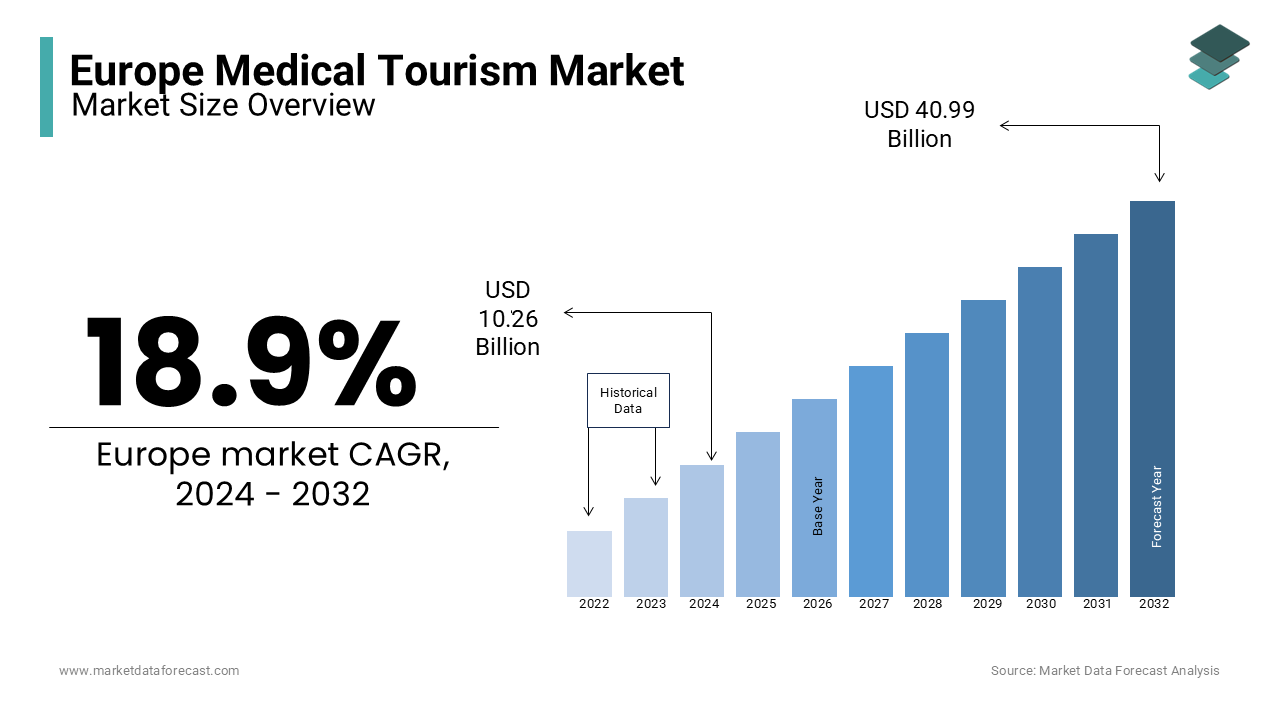Europe Medical Tourism Market Research Report – Segmented by Treatment Type, Country (UK, France, Spain, Germany, Italy, Russia, Sweden, Denmark, Switzerland, Netherlands, Turkey, Czech Republic and Rest of Europe) - Industry Analysis on Size, Share, COVID-19 Impact, Trends & Growth Forecast (2024 to 2032)
Europe Medical Tourism Market Size (2024 to 2032)
The size of the European medical tourism market is expected to be worth USD 40.99 billion by 2032 from USD 10.26 billion in 2024, growing at a CAGR of 18.9% during the forecast period.

There are numerous growth factors for the medical tourism market in Europe such as the availability of conventional medical techniques, growing coherence with and maintaining international quality standards, high-quality service, and mobility of medical insurance and medical tourism marketing.
The European medical tourism market is anticipated to witness significant development throughout the forecast period as developing countries are progressively moving towards advancements in technology and quality management in the healthcare and medical sectors. It is also anticipated that the innovative developments of healthcare services by different private and government firms are further expected to augment the development of the European medical tourism market.
Many variables such as high treatment costs and conditions of long waiting time for medical practices, technological and innovative advancements, and further market development are propelling the European medical tourism market. Still, the market is hindered by many variables such as strict documentation forms, issues related to visa authorization, and limited scope of protection.
This research report on the European medical tourism market has been segmented and sub-segmented into the following categories:
Europe Medical Tourism Market Analysis By Treatment Type
- Cardiovascular Treatment
- Orthopedic Treatment
- Fertility Treatment
- Neurological Treatment
- Dental Treatment
- Cancer Treatment
- Cosmetic Treatment
- Others
Europe Medical Tourism Market Analysis By Country
- UK
- France
- Spain
- Germany
- Italy
- Russia
- Sweden
- Denmark
- Switzerland
- Netherlands
- Turkey
- Czech Republic
- Rest of Europe
Geographically, the European medical tourism market is expected to account for a significant share of the global market during the forecast period. As per research published this year by PwC, the consultant, medical tourism is already on the rise in Central and Eastern Europe. As per the Polish Medical Tourism Association, 488,000 foreign patients traveled to Poland for treatment in the last few years. Europe is majorly segmented geographically into the UK, France, Germany, Russia, Sweden, Czech Republic, Denmark, Italy, Switzerland, and the Rest of Europe. From the west and east, patients come to Central Europe. Some from Germany, the United Kingdom, and the Nordic countries generally choose one-day treatments or stay in medical spas, attracted by affordable prices that can be two to three times lower than in their native countries. Germany is anticipated to be the fastest-growing region in Europe during the forecast period.
Every year, nearly 20,000 to 25,000 couples try assisted reproductive technology services abroad. An additional 4.0 percent of EU citizens in other nations are receiving treatment. In most European nations, fertility treatment practices are restricted. In other central European countries, the development of medical tourism in Poland has been reflected. Hungary also has a reputation for specializing in international dental services, while the Czech Republic has established a cataract surgery industry. Poland is known both for its cosmetic surgeons and for its dentists.
KEY MARKET PLAYERS
Some of the key market participants operating in the European medical tourism market analyzed in this report are Min-Sheng General Hospital, Apollo Hospitals Enterprise Limited, Samitivej Sukhumvit, Fortis Healthcare Ltd., Prince Court Medical Center, Bangkok Hospital Medical Center, Asian Heart Institute KPJ Healthcare Berhad, Raffles Medical Group, and Bumrungrad International Hospital.
Related Reports
Access the study in MULTIPLE FORMATS
Purchase options starting from $ 2000
Didn’t find what you’re looking for?
TALK TO OUR ANALYST TEAM
Need something within your budget?
NO WORRIES! WE GOT YOU COVERED!
Call us on: +1 888 702 9696 (U.S Toll Free)
Write to us: [email protected]
